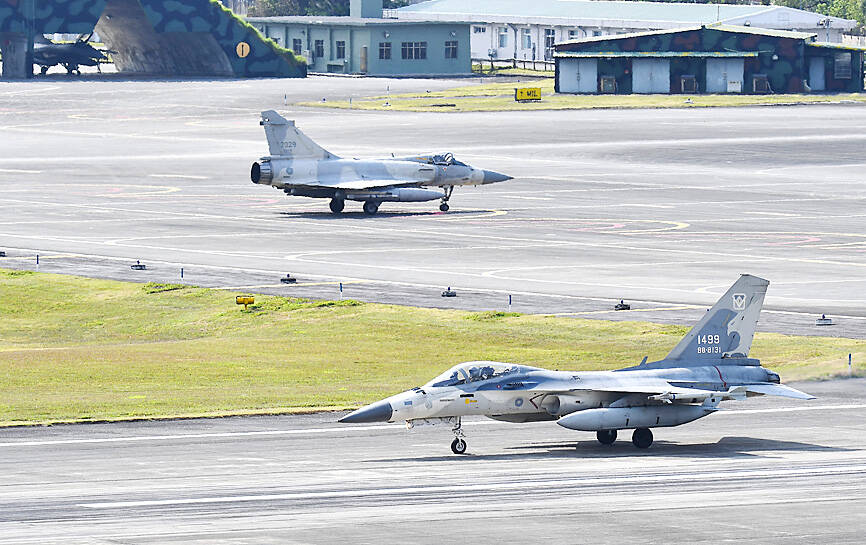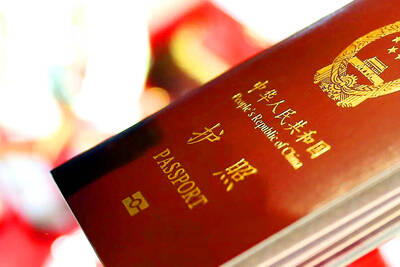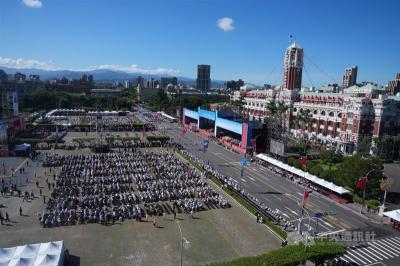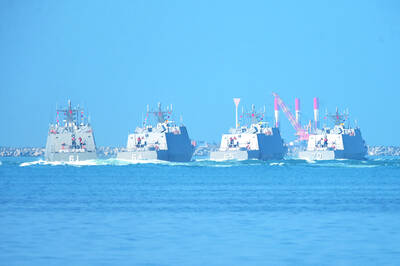Pilots of F-16V, Mirage 2000 and other jets have been participating in joint training at Hualien County’s Chiashan Air Force Base to bolster the military’s ability to engage in asymmetric warfare, military officials said yesterday.
Lieutenant General Sun Lien-sheng (孫連勝), deputy commander of the Air Force Command, said at the launch of the joint training earlier this month that such exercises would be held more frequently to gain an understanding of the limitations and capabilities of different military branches, and to determine what support they need to closely work with one another during wartime.
The goal is to enable Taiwan’s relatively smaller military to deter China from invading, Sun added.

Photo: Yu Tai-lang, Taipei Times
Military officials yesterday said that the lesson from Russia’s war in Ukraine is to build an asymmetric military force to stall, destroy or paralyze the enemy.
The air force is mostly asked to support other military branches’ missions, so joint training must first start with combat precision training for the air force, and then expand to include the other two branches of the military, they said.
To improve training for second-generation aircraft, the air force in 2001 commissioned the Chungshan Institute of Science and Technology to develop the Tactic Analysis System (TAS), which was merged with the existing telemetry system.
TAS was modified and refined based on actual air force operations. It includes a mission display and control system, an airborne targeting pod and relay stations.
The TAS system has been upgraded to be used with the Air Combat Training Instrumentation System (ACTIS) targeting pod for military exercises, the officials said.
Aside from F-16Vs, Mirage 2000s and Indigenous Defense Fighters, Taiwan’s AIDC T-5 Brave Eagle trainer jet has also been equipped with the ACTIS targeting pod, they said.
The Brave Eagle’s test missions now include air-to-surface bombing, the officials added.
In other developments, the Ministry of National Defense last month began expanding the number of reservists nationwide, military personnel said.
New reserve brigades have been formed in Taichung, Kaohsiung, New Taipei City and Hsinchu County, they said.
A reserve brigade now consists of nearly 200 personnel, up from 24 under the previous policy, they said, adding that brigade commanders, battalion commanders and other important staff are on active duty.
The ministry is expected to form four more reserve brigades in the second half of this year and another 10 next year, military sources said.
Chen Wen-jia (陳文甲), a senior consultant for the Institute for National Policy Research, said that having reserve brigades in 18 cities and counties would help mobilize reservists, but “regulations governing the mobilization of reservists must be flexible.”
Su Tzu-yun (蘇紫雲), a research fellow at the government-funded Institute for National Defense and Security Research, said rules related to reservists are expected to be greatly improved.

The Ministry of the Interior (MOI) is to tighten rules for candidates running for public office, requiring them to declare that they do not hold a Chinese household registration or passport, and that they possess no other foreign citizenship. The requirement was set out in a draft amendment to the Enforcement Rules of the Public Officials Election and Recall Act (公職人員選舉罷免法 ) released by the ministry on Thursday. Under the proposal, candidates would need to make the declaration when submitting their registration forms, which would be published in the official election bulletin. The move follows the removal of several elected officials who were

The Republic of China (ROC) is celebrating its 114th Double Ten National Day today, featuring military parades and a variety of performances and speeches in front of the Presidential Office in Taipei. The Taiwan Taiko Association opened the celebrations with a 100-drummer performance, including young percussionists. As per tradition, an air force Mirage 2000 fighter jet flew over the Presidential Office as a part of the performance. The Honor Guards of the ROC and its marching band also heralded in a military parade. Students from Taichung's Shin Min High School then followed with a colorful performance using floral imagery to represent Taiwan's alternate name

FOUR DESIGNATED AREAS: Notices were issued for live-fire exercises in waters south and northwest of Penghu, northeast of Keelung and west of Kaohsiung, they said The military is planning three major annual exercises across the army, navy and air force this month, with the navy’s “Hai Chiang” (海強, “Sea Strong”) drills running from today through Thursday, the Ministry of National Defense said yesterday. The Hai Chiang exercise, which is to take place in waters surrounding Taiwan, would feature P-3C Orion maritime patrol aircraft and S-70C anti-submarine helicopters, the ministry said, adding that the drills aim to bolster the nation’s offshore defensive capabilities. China has intensified military and psychological pressure against Taiwan, repeatedly sending warplanes and vessels into areas near the nation’s air defense identification zone and across

A Chinese takeover of Taiwan would severely threaten the national security of the US, Japan, the Philippines and other nations, while global economic losses could reach US$10 trillion, National Security Council Deputy Secretary-General Lin Fei-fan (林飛帆) wrote in an article published yesterday in Foreign Affairs. “The future of Taiwan is not merely a regional concern; it is a test of whether the international order can withstand the pressure of authoritarian expansionism,” Lin wrote in the article titled “Taiwan’s Plan for Peace Through Strength — How Investments in Resilience Can Deter Beijing.” Chinese President Xi Jinping’s (習近平) intent to take Taiwan by force